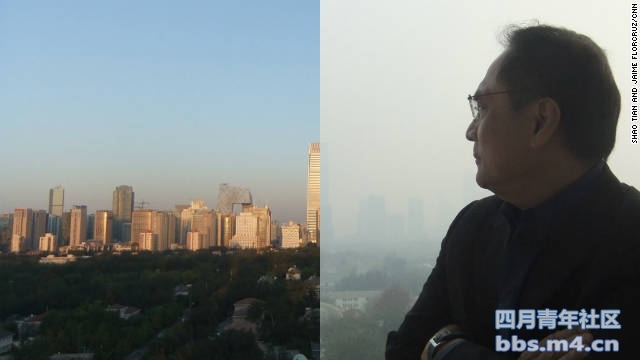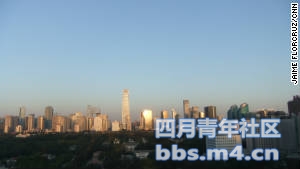|
|
【中文标题】中国空气污染:“轻度污染”还是'有害“?
【原文标题】China air pollution: 'Slightly polluted' or 'hazardous'?
【登载媒体】CNN
【来源地址】http://edition.cnn.com/2011/11/17/world/asia/china-beijing-air-pollution/index.html
【译者】doraemonls
【翻译方式】人工
【原文库链接】http://bbs.m4.cn/thread-3239915-1-1.html
【声明】欢迎转载,请务必注明译者和出处 bbs.m4.cn。
【译文】

This photo shows two images of the view from CNN's Beijing Bureau, one from a blue sky day and one from a polluted day.这两张照片摄自CNN北京分社,一张是晴朗蓝天,另一张则是污染的大气。
As I type this week's column, I look out of my office window and stare at a depressing sight. A heavy blanket of smog and dust hangs over the sky. Buildings nearby are barely visible. Air is barely breathable.
我在写下本周专栏的时候,抬头看看窗外,看到了一片压抑的景象。灰尘烟雾俨如毛毯一样覆盖着整片天空。附近的建筑隐约可见,肮脏的空气简直无法呼吸。
I checked the website of the China National Environmental Monitoring Center. It rated Beijing's air quality for the day as "slightly polluted".On Twitter, however, the U.S. Embassy's BeijingAir, an air-quality monitoring app, rated the air pollution level as "hazardous."
我登上中国环境监测中心的网站。网站标注北京当天的天气是“轻微污染”。然而,在Twitter上,一个检测空气质量的应用程序,美国大使馆的“北京天气”却显示当天空气污染级别是“危险”。
What gives?
这是什么原因呢?
I visited the Beijing Municipal Environmental Monitoring Center (BMEMC) to find out. "We've been using equipment imported from the U.S. to monitor air quality ever since we set up in 1987," Vice Director Hua Lei tells me. "We use the same techniques as the American system."
为了探究真相,我采访了北京市环境监测中心(BMEMC)。霍华(音译)副主任告诉我:“从1987年中心成立以来,我们就一直使用从美国进口的设备监测空气质量。我们和美国用的是一样的技术。”

CNN's Beijing Bureau Chief Jaime FlorCruz looks out on Beijing's pollution on November 16.
11月16日, CNN北京分社社长Jaime FlorCruz望着窗外污染的大气。

This photo, taken from CNN's Beijing Bureau in September, shows the city on a blue sky day.
这张图也摄自CNN北京分社,却是在9月拍摄的。城市上方是晴朗的蓝天。
But there is one difference: the Chinese monitoring stations measure particulates 10 micrometers or smaller, a standard known as PM10.
但却仍有不同:中国监测站测量的大气微粒标准是为10微米及以下,即标准值是PM10。
BeijingAir, which reports the reading of an air monitory device installed on the roof of the U.S. embassy building, uses the PM2.5, which measures tiny airborne particulates that cause smog and are deemed more harmful. It ranks air quality from 1 (cleanest) to 500 (dirtiest).
“北京天气”是通过在房屋顶上安装空气质量检测设备来报告数据。在美国背景大使馆,“北京天气”对造成烟雾的有害大气微粒的测量标准是PM2.5。空气质量级别从1(最洁净)到500(最肮脏)。
"It measures the very fine particulates which are health concerns, things less than 2.5 micrometers," U.S. ambassador Gary Locke tells CNN's Kristie Lu Stout. "Acceptable range in the U.S. is 35. Here we are near 400, more than 10 times the acceptable level."
前些天,CNN记者Kristie Lu Stout采访美国驻华大使骆家辉时,骆家辉告诉他:“使用低于2.5微米的测量标准显然更加关注大众的健康。在美国,可接受的空气质量级别是35,在北京是400,这超过前者10倍还要多。”
That was a few days earlier, when Kristie interviewed the American envoy.
Thursday's reading on BeijingAir: 321.
“北京空气”周四的指数是321。
I have lived in Beijing for nearly 40 years and have seen the air's quality go from bad to worse. I never imagined it to be this bad.
我在北京住了将近40年,眼看着空气质量每况愈下,却从未想到情况这么严重。
Experts blame the thick haze on rapid urbanization and industrialization. "What come with them are cars, industries and pollution sources from all kinds of directions," says Wu Changhua, China director of The Climate Group, a London-based international organization.
专家把这一问题归咎于快速发展的城市化和工业化。气候组织是一个总部设在伦敦的国际组织,其中国区总监吴昌华(音译)说到:“大气污染来自于汽车尾气、工业污染、以及其他各方面的污染源。”
Beijing, for instance, burned some 27 million tons of coal in 2010, according to state-run media. Despite efforts to limit the number cars with an auto-plate lottery, it's estimated that Beijing now has over 5 million cars, up from about 3.5 million in 2008.
根据国营媒体报道,2010年,北京使用了2700万吨煤。尽管有单双号、以及摇号等政策限制汽车数量,但粗略估计目前北京已有超过500万辆的汽车,2008年时,约有350万辆。
Pollution is more acute because of the sheer size of the city's population (17 million) and the rapid speed of its economic growth, experts say.
专家称,由于北京巨大的人口数量和迅速发展的经济增长,污染问题将更加严重。
Some say the costs are mounting. "They are paying a price first of all individually by premature deaths," says Achim Steiner, executive director of the UN Environment Program (UNEP), who is in Beijing to launch the agency's "green economy" report. "China as a society also pays a heavy price in terms of healthcare and lost productivity."
一些人认为污染导致的开销不断上升。Achim Steiner是联合国环境计划署的执行主任,负责推出该机构在北京的“绿色经济”报告。他说:“人民付出的代价是过早的死亡。中国社会也在通过增加的医疗保健和生产力降低的形式付出代价。”
The picture is not all dark.
但前景并非一片黑暗。
China acknowledges the problems and has pledged to solve them. "If you look at China's five-year plan (for 2011-2015), there are green-development plans that set high ambitions in energy efficiency, renewable energy as well as pollution reductions and control," notes Wu.
UNEP's Steiner compliments China as the world's biggest investor in renewable energy for spending $49 billion last year.
中国已经承认了并且承诺解决这些问题。吴昌华提到:“如果你看一下中国2011-2015的五年计划,就会发现中国已经在能源效率、可再生能源以及控制污染减少排放方面设立了绿色发展计划,并且雄心勃勃。”联合国环境署的Steiner称赞中国是世界上可再生能源最大投资者,去年中国已经支出了490亿美元。
On the grassroots level, rumblings of a green movement are starting to be heard. Huanbao (environmental protection) is now a catch-phrase among residents and local journalists. Public complaints over Beijing's worsening air quality are common.
绿色运动也开始在基层受到重视。环保是在居民和当地记者常挂在嘴边的一句话。对北京空气质量恶化的投诉愈发常见。
In recent days, some Chinese microbloggers posted pictures of the national Olympics stadium, also known as the "Birds Nest", taken on blue-sky days during the 2008 Olympics, juxtaposed with pictures of the stadium covered with smog.
最近一段时间,中国的微博上贴出了国家奥林匹克公园—鸟巢的一组图片,将2008年的蓝天和现在烟雾笼罩的天空图片并列作对比。
In response, the Beijing Municipal Environmental Monitoring Center has opened its facilities to the public once a week. "We receive scores of residents and local journalists," Hua says as she shows me inside a hall equipped with computers and a huge TV screen. "We show them how we do our monitoring, show how equipments work, and explain our standards and systems. It's good that people are now interested in what we do."
对此,北京市环保监测中心每周一对公众开放设施。霍华一边带我参观大厅里的电脑和巨大的电视屏幕显示器,一边告诉我:“我们已经接待了几十位居民和当地记者了,告诉他们我们如何做监测,设备如何工作,并且向公众解释我们的标准和系统。人们对我们的工作感兴趣,这是件好事。”
Hua says China may adopt more stringent PM2.5 standards, but gradually. "It takes time to improve the standards we are using and to gradually adopt international standards," she says. "We'll gradually raise our standards and it is possible that we'll adopt higher standards as the air quality in China gets better."
霍华提到中国可能会逐步采取更严格的PM2.5的标准。她说:“改进当前所用的系统标准并逐步适应国际化的标准还需要时间。我们会逐步提高标准,采取更高的标准并促进改善空气质量。”
A number of Chinese netizens are pushing Beijing to change standards immediately. Pan Shiyi, a Chinese real estate tycoon, recently asked his 7.5 million fans on Sina Weibo, a microblogging social network similar to Twitter, to vote on whether Beijing should adopt more stringent standards. Of the 40,000 who voted, 92% agreed that "the authorities adopt PM2.5 this year."
一些中国网民正在敦促北京立刻改变标准。中国的房地产大亨潘石屹,在新浪微薄上有750万粉丝。他发起了一个投票,题为呼吁环保部尽快出台PM2.5的强制标准。超过4万人投票,有大约92%的人同意环保部门应该在今年出台标准。
"I think that's definitely the direction to go," says Wu of The Climate Group. "China so far has been monitoring PM10 and from the epidemiological perspective, we all know when the particles are bigger they don't go too deep into your lungs and respiratory system. But actually, the more hazardous polluter will be PM2.5."
气候组织的吴昌华说道:“我认为那肯定是今后发展的方向。目前为止,中国从流行病学的角度才一直采用PM10的标准。众所周知,颗粒大到一定程度,肯定无法进入肺和呼吸系统的深处。但实际上,更危险的污染源却是在PM2.5左右的微粒。”
Wu hopes the Chinese government will soon adopt the higher standards, although she is not sure how quickly it can be done. "It's being debated at this moment," she says.
吴昌华希望中国政府能够尽快采取更高的标准,尽管她不清楚这个过程到底要多久。她说:“这一问题目前尚在争论。”
There are encouraging signals this week. Chinese media reports say that at least two cities in south China have decided to adopt PM 2.5 on trial basis.
这周出现了一些令人欢欣鼓舞的信号。中国媒体报道说至少有两个南方城市已经决定采用PM2.5的标准试行。
Will Beijing follow suit?
北京会效仿吗?
Wu hopes for quicker actions. "I have an 11-year-old child," she says. "I really wish for better air quality, for the nation's authorities to do something not just for us but for future generations. That remains a concern for parents like me and many others."
吴昌华希望北京能迅速行动。她说:“我的孩子11岁了,我真心希望空气质量能够得到改善。我相信很多家长都像我一样关注这件事。这些事不只是国家应该为我们做的,更是为我们的子孙后代做的。”
*************华丽丽的分割线************
新手贴,继续求拍砖{:soso_e183:}
|
评分
-
1
查看全部评分
-
|